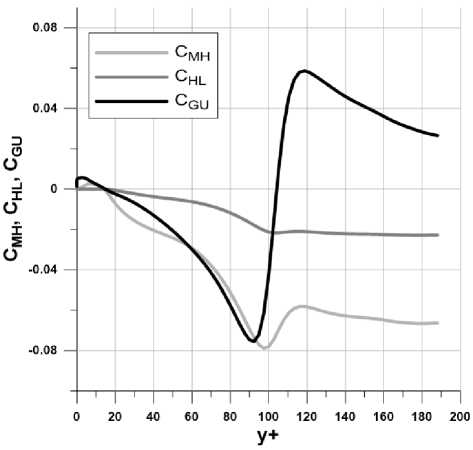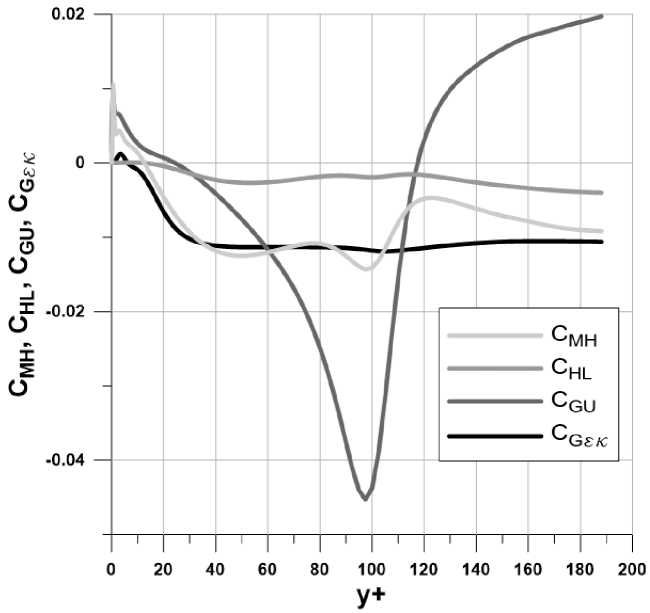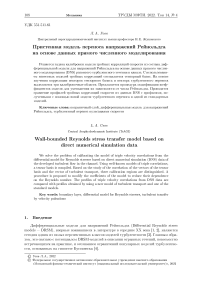Пристенная модель переноса напряжений Рейнольдса на основе данных прямого численного моделирования
Автор: Усов Л.А.
Журнал: Труды Московского физико-технического института @trudy-mipt
Рубрика: Механика
Статья в выпуске: 4 (56) т.14, 2022 года.
Бесплатный доступ
Решается задача калибровки модели тройных корреляций скорости из состава дифференциальной модели для напряжений Рейнольдса на основе данных прямого численного моделирования (DNS) развитого турбулентного течения в канале. С использованием известных моделей тройных корреляций составляется тензорный базис. На основе изучения корреляции векторов тензорного базиса и вектора турбулентного переноса выделяются три калибровочные области. Предлагается процедура модификации коэффициентов модели для уменьшения их зависимости от числа Рейнольдса. Проводится сравнение профилей тройных корреляций скорости из данных DNS с профилями, полученными с помощью новой модели турбулентного переноса и одной из стандартных моделей.
Пограничный слой, дифференциальная модель для напряжений рейнольдса, турбулентный перенос пульсациями скорости
Короткий адрес: https://sciup.org/142236622
IDR: 142236622 | УДК: 551.511.61
Текст научной статьи Пристенная модель переноса напряжений Рейнольдса на основе данных прямого численного моделирования
Дифференциальные модели для напряжений Рейнольдса. (Differential Reynolds stress models — DRSM), впервые появившиеся в литературе в середине XX века. [1, 2], являются сегодня одним из самых перспективных классов моделей турбулентности [3]. Главным образом, это связано с потенциалом DRSM-моделей в описании отрывных течений, повсеместно встречающихся на. практике, и осознанием ограничений популярных моделей турбулентности, основанных на гипотезе Буссинеска [4].
Рассмотрим уравнения Навье-Стокса для несжимаемой жидкости, осредненные по Рейнольдсу (здесь и далее по повторяющимся индексам ведется суммирование):
эи _ 0 эи у dUi _ 1 эр Эии v d^Ui дхі , dt j Эх j р дхі Эх j Эх j Эх j
Здесь Ui — средняя скор ость жидкости, Р — среднее давление, р — плотность (константа), и — коэффициент вязкости (константа), Ui — пульсация скорости, черта — символ осреднения по Рейнольдсу. Тензор UiUj называется тензором напряжений Рейнольдса и описывает средний эффект турбулентного переноса импульса.
В моделях класса DRSM напряжения Рейнольдса определяются из решения уравнений в частных производных, структура которых точно выводится из уравнений Навье-Стокса. Эти уравнения содержат члены, требующие дополнительных замыкающих соотношений. Один из таких членов, который является объектом исследования для данной работы, — это тензор тройных корреляций скорости UiUjи^ • Он описывает средний эффект турбулентного переноса напряжений Рейнольдса пульсациями скорости.
В литературе можно найти несколько работ, посвященных моделированию турбулентного переноса напряжений Рейнольдса [5-12]. Одни из наиболее известных — модель Ханьялича и Лаундера [5] и модель Меллора и Херринга [6]. Эти модели были объединены и дополнены членами, содержащими градиенты средней скорости, в работе [13], где помимо прочего вводится глубоко математически обоснованная теория использования тензорных величин для адекватной начальной формулировки модели. Результаты последнего исследования были расширены в работе [14], посвященной моделированию турбулентного переноса скалярного параметра. Несмотря на все усилия, уровень точности моделей тройных корреляций скорости оставляет желать лучшего [4], и любые продвижения в этой области представляют интерес с точки зрения практического моделирования турбулентности.
Данная статья продолжает это направление исследований. Внимание уделяется моделированию тройных корреляций скорости в турбулентном течении вблизи стенки по современным данным прямого численного моделирования (Direct Numerical Simulation — DNS) течения в канале [15] в диапазоне чисел Рейнольдса 180 < ReT< 5200. Здесь ReT = UTh/v — число Рейнольдса, вычисленное по динамической скорости UT = ( t w /р)1/ и полувысоте канала h,Tw — трение на стенке. Интерес к пристенному моделированию турбулентности связан с активным развитием гибридных методов расчета турбулентных течений, в которых вблизи стенок решаются осредненные по Рейнольдсу уравнения Навье-Стокса, а в развитой турбулентности — уравнения метода крупных вихрей (Large Eddy Simulation — LES) [16].
Структура данной статьи следующая. В разделе 2 на основе [13] и [14] формулируется «базовая» модель. В разделе 3 к базовой модели добавляется тензорный член иной физической и математической природы, а также производится выделение нескольких расчетных областей на основе изучения коллинеарности вектора турбулентного переноса и векторов выбранного ранее тензорного базиса. Раздел 4 посвящен описанию нового метода калибровки, направленного на снижение зависимости калибровочных коэффициентов от числа Рейнольдса и придание модели большей универсальности. В разделе 5 приводится сравнение профилей тройных корреляций, полученных с помощью априорно откалиброванной по данным DNS модели, с данными DNS и одной из стандартных моделей турбулентного переноса [17]. На основе полученных результатов предлагается несколько вариантов дальнейшего развития модели.
2. Описание и исследование базовой модели
Точное уравнение для тензора напряжений Рейнольдса в несжимаемой среде имеет следующий вид [4]:
du-iUj O
Ot Oxk
____тт . _______ vuiu j UiUjUk + UiUjuk -т,"^ ^^s—' 2 OX^
гз k
⏟
___OU ,
"/'Д '
Oxk
-
__OU
Uj "k
Oxk
-
1 U^ X+U, - (2, p у Ох, Oxi) у
⏟⏞ ⏟
Oui Ou, Oxk Oxk
-
v O2UiUj
2 OxkOxk
)
Рал
Г гз
П із
e h. ^гз
В это уравнение входят:
Pi, — производство напряжений (не требует полуэмпирического замыкания);
П і, — корреляция «скорость - градиент давления»;
Е^- — «однородная» часть тензора скоростей диссипации напряжений;
Tijk — тензор турбулентных потоков напряжений Рейнольдса под действием пульсаций скорости.
Обратимся к тензору Ti,k = UiUjUk. Следуя работе [14], начнем с модели этого тензора вида k2 OUiUj к____OUiUj
і ' + CHL-rUk ui -^- + Е^ Oxk Е^ Oxi
UiUjUk =
-
^ ( cmh
{ i ^ j ^k} X
к OuUj , Р OuinJ \
+ C gu S "охр + C gu i^^ki "OXT) ■ (1)
Здесь символ X, { i ^ j ^ k } Aijk = Ai,k + Ajki + A^, обозначает суммирование по циклическим перестановкам индексов, к = UiUi/2 — кинетическая энергия турбулентности, е һ = ЕД2 — «однородная» скорость ее диссипации, Si, и Uj — тензоры скоростей деформации и ротации соответственно:
Sij =
1 оип + оид = i (up - оид
2 Ох , Oxi , ij 2 Ох , Oxi ‘
Модель (1) содержит эмпирические коэффициенты C mh ,C hl ,C gu ,C' gu, которые могут быть константами либо функциями инвариантов введенных выше тензоров [4]. В данной работе калибровка модели проводилась по данным DNS о развитом турбулентном течении в канале [15]. Это — строго тонкослойное течение, направленное вдоль оси х, средние параметры которого зависят только от у. В таком случае в уравнения для UiUj входят лишь 4 из 10 возможных тройных корреляций скорости:
U2V, v3,vw2,uv2.
В тензорах скоростей деформации и ротации ненулевыми являются два компонента:
|
0 |
1 dU 2 Әу |
0 |
0 |
1 8U 2 Әу |
0 |
||
|
Sij = |
I 1 9U 2 Әу |
0 |
0 1 ’ |
^ij = |
1 1 әи 2 ду |
0 |
0 |
|
0 |
0 |
0 |
0 |
0 |
0 |
Это делает невозможным независимую калибровку коэффициентов Cgu и C' G u- выражения при этих коэффициентах пропорциональны друг другу. Поступим, как предлагается в [13]: приравняем C gu и C'G u друг другу. Тогда модель примет вид, который назовем «базовым»:
UiUjUk =
-
^ / k2 Ouiu, к Ouiu, гк OUk Ouiuj \ z9x
(Cmh 7"X7T + C hl 7*UkUi"aXT + C gu (U"XP ' (2) { i ^ j ^ k }
Здесь первое слагаемое позаимствовано из модели Меллора и Херринга (далее — МН) [6], второе - из модели Ханьялича и Лаундера (далее — HL) [5], а третье было предложено в работе [13] и связано с градиентами средней скорости (далее — GU). В приведенной формуле сомножители перед тензорными величинами имеют смысл масштабных коэффициентов, подобранных исходя из физических соображений: они содержат в себе характерные величины, связанные с крупномасштабной турбулентностью, которая и определяет турбулентный перенос.
Если подставить в (2) все величины из DNS для некоторой точки у+ = const в пограничном слое, то получится переопределенная система из 4 уравнений на 3 неизвестных: Смн ,C hl ,C gu- Ее можно решить, например, методом наименьших квадратов. Однако расчеты по базовой модели выявили два существенных недостатка такого подхода.
Первый из них связан с особенностью поведения компонент пульсаций скорости при у+ ^ 0 [4]:
и ~ у+, ,v ~ (у+)2, ш ~ у+.
Исходя из этого можно ожидать, что тройные корреляции при у+ ^ 0 имеют следующую асимптотику:
и2г ~ (у+)4, v3 ~ (у+)6, vw2 ~ (у+ )4, иг2 ~ (у+)5. (3)
Эта асимптотика была проверена по данным DNS течения в канале при ReT = 2000. Была построена аппроксимация зависимости ln uiUjUk от ln у+ в диапазоне 0 < у+ < 1, которая показала, что и2г ~ (у+)3'90, v3 ~ (у+)5'60, гш2 ~ (у+ )3’93, иг2 ~ (у+ )4’81.
Это близко к теоретически ожидаемым степеням. Значит, асимптотики (3) можно считать верными и использовать их для изучения поведения коэффициентов Смн ,C hl ,C gu пРи у+ ^ 0. ___
Рассмотрим теперь уравнение для u2v:
u2v ~(у+)4
к2 ди2
-СМН ;., Е^ ду ⏟⏞
~<У+)5
к \^Эи2 __диг! к3 ЭС диг
- hl У v Уу + иг1у - gu (Z^y • 2 ау^У . ⏟ ⏞ ⏟⏞
~(у+)7
~(У+)8
Здесь помимо (3) на основании [4] используется также асимптотика кинетической энергии турбулентности: к ~ (у+)2, и «однородной» скорости ее диссипации: е ^ ~ (у+)0- Видно, что при у+ ^ 0 хотя бы один из коэффициентов должен иметь асимптотику
Смн ~
1 у+’
Chl ~ Ул' Cgu ~ (у+)4'
то есть неограниченно расти при у+ ^ 0. Аналогичные результаты получаются и для остальных компонент тензора Tijk- Попытки калибровки базовой модели подтвердили эту гипотезу, а именно, показали сингулярность коэффициентов вблизи стенки.
Устранить подобную сингулярность позволяет изменение масштабных коэффициентов при тензорных величинах в (2). Идея состоит в том, чтобы достаточно сильно понизить степень этих коэффициентов по у+. Это может позволить повысить степень Смн , C hl , C gu по у+ вблизи стенки до неотрицательной. Заметим, что в развитой турбулентности к/Е^ — характерный масштаб времени крупных вихрей. Вблизи стенки величина к/Еһ может стать меньше временного масштаба Колмогорова ( у/е^ )1/2, что делает к/Еһ непригодным выражением для определения масштаба времени. Чтобы избежать этой проблемы, в [14] предлагается использовать «гибридный» масштаб:
T = max
( -Ст •
где Ст = 6 — эмпирическая константа [18]. Ctj эемясь избежать излома в профиле Т. порожденного функцией max, мы решили определить характерное время крупных вихрей как корень из суммы квадратов величин k/eh и временного масштаба Колмогорова:
Т =

+ СТ £.
Покажем, что «гибридный» масштаб времени может позволить избавиться от проблемы сингулярности, если включить его в модель (2) следующим образом:
u2v ~(у+)4
-Смн kT— - C hl Т оу
⏟⏞
~(у + )3
du2 „__дин н2—--+ 2uv —— ду ду
- C gu кТ 2 • 2
~($/+) 5
⏟⏞
~(-у+')4
OU дин ду ду
Видно, что при у+ ^ 0 хотя бы один из коэффициентов должен иметь асимптотику:
С мн ~ у+,
Chl ~ УЙ ■
C gu ~ 1.
Модель может обеспечить регулярность коэффициентов за счет членов при Смн и C gu- Однако уверенности в том, что коэффициент C hl будет при этом регулярным, по-прежнему нет. Решение системы (2) с новым временным масштабом Т дает профили коэффициентов, представленные на рис. 1 (течение в канале, ReT = 2000). Видно, что теперь сингулярности при у+ ^ 0 не наблюдается.

Рис. 1. Поведение коэффициентов модели (2) с «гибридным» масштабом (4) вблизи стенки канала.
Однако на рис. 1 виден второй недостаток базовой модели. В области вблизи у+ = 100 наблюдается странное поведение коэффициента C gu^ а именно, весьма резкое, нефизич-ное изменение значения на. почти противоположное. Это могло быть связано с тем, что в рассматриваемой области наблюдалась сингулярность коэффициента C gu^ которая сглаживалась за. счет решения системы уравнений методом наименьших квадратов.
Проблему можно попытаться решить введением новых независимых слагаемых в модель (2). Поиск привел к включению в модель члена, вида.
Ui Uj Uk = ...
-
∑︁
{ i ^ j ^ k }
CGekkT ujuk
д д$і
( к )) •
Влияние такого расширения модели будет рассмотрено в следующем разделе.
3. Формулировка окончательной модели
Идея введения члена вида (5) состоит в том, что в него входит градиент не от тензорной, а от скалярной величины, то еств он имеет иное физическое и математическое значение. По этой причине данный член потенциально может скомпенсировать недостатки базовой модели в тех областях, где они имеются.
Решение системы уравнений модели (5) дало профили коэффициентов, изображенные на рис. 2. При этом система уравнений из четырех уравнений с четырьмя неизвестными по-прежнему решалась методом наименьших квадратов, поскольку точное решение не допускала существующая в какой-то области сингулярность. Из полученных профилей видно, что поведение коэффициента C gu пРи члене с градиентами средней скорости немного улучшилось, но все еще существует необъяснимо резкий переход через ось абсцисс в области у+ = 100.

Рис. 2. Поведение коэффициентов модели (5)
Поскольку основная проблема связана с некорректным решением системы линейных уравнений в некоторых областях, то для более глубокого понимания причин этого явления мы решили изучить «коллинеарность» векторов левой и правой частей. А именно, четырехмерного вектора, состоящего из компонент турбулентного переноса (шТй, vvv, wwv, Uvv) с базисными векторами:
Список литературы Пристенная модель переноса напряжений Рейнольдса на основе данных прямого численного моделирования
- Chou P. Y. On the velocity correlations and the solution of the equations of turbulent fluctuation 11 Quart. Appl. Math. 1945. V. 3. P. 38-54.
- Rotta J. Statistische Theorie nichthomogener Turbulenz // Z. Phvs. 1951. V. 129. P. 547572.
- Differential Reynolds Stress Modeling for Separating Flows in Industrial Aerodynamics / Ed. By B. Eisfeld — Springer Tracts in Mechanical Engineering, 2015. P. 101.
- Modelling turbulence in engineering and the environment: second-moment routes to closure / Ed. By Hanjalic K., Launder B. Cambridge university press, 2011.
- Hanjalic K., Launder B. A Reynolds stress model of turbulence and its application to thin shear flows 11 Journal of fluid Mechanics. 1972. V. 52, N 4. P. 609-638.
- Mellor G.L., Herring. H.J. A survey of the mean turbulent field closure models // AIAA journal. 1973. V. 11, N 5. P. 590-599.
- Cormack D.E., Leal L.G., Seinfeld J. H. SAn evaluation of mean Reynolds stress turbulence models: the triple velocity correlation //J. Fluids Eng. 1978. V. 100, N 1. P. 47-54.
- Lumley J.L. Computational modeling of turbulent flows // Advances in applied mechanics. 1979. V. 18. P. 123-176.
- Yoshizawa A. Statistical evaluation of the triple velocity correlation and the pressure-velocity correlation in shear turbulence // Journal of the Physical Society of Japan. 1982. V. 51, N 7. P. 2326-2337.
- Magnaudet J. Modelling of inhomogeneous turbulence in the absence of mean velocity gradients // Advances in Turbulence IV. Springer : Dordrecht, 1993. P. 525-531.
- Hanjalic K. Advanced turbulence closure models: a view of current status and future prospects // International Journal of Heat and Fluid Flow. 1994. V. 15, N 3. P. 178-203.
- Craft T.J. Developments in a low-Reynolds-number second-moment closure and its application to separating and reattaching flows // International Journal of Heat and Fluid Flow. 1998. V. 19, N 5. P. 541-548.
- Younis B.A., Gatski T.B., Speziale C.G. Towards a rational model for the triple velocity correlations of turbulence // Proceedings of the Royal Society of London. Series A: Mathematical, Physical and Engineering Sciences. 2000. V. 456, N 1996. P. 909-920.
- Younis B.A., Speziale C.G., Clark T.T. A rational model for the turbulent scalar fluxes // Proceedings of the Royal Society A: Mathematical, Physical and Engineering Sciences. 2005. V. 461, N 2054. P. 575-594.
- Lee M., Moser R. D. Direct numerical simulation of turbulent channel flow up to Rer = 5200 11 Journal of fluid mechanics. 2015. V. 774. P. 395-415.
- Chaouat B. The state of the art of hybrid RANS/LES modeling for the simulation of turbulent flows // Flow, Turbulence and Combustion. 2017. V. 99, N 2. P. 279-327.
- Jakirlic S., Hanjalic K. A new approach to modelling near-wall turbulence energy and stress dissipation //J. Fluid Mech. 2002. V. 539. P. 139-166.
- Durbin P.A. Near-wall turbulence closure modeling without «damping functions»// Theoretical and computational fluid dynamics. 1991. V. 3, N 1. P. 1-13.
- Deshpande R., Monty J.P., Marusic I. Active and inactive components of the streamwise velocity in wall-bounded turbulence // Journal of Fluid Mechanics. 2021. V. 914.


